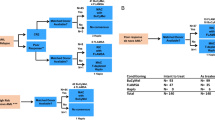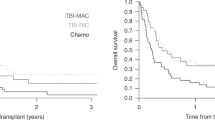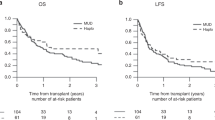Abstract
EFS for children with ALL continues to increase and is predicted to reach 90% with current therapy. Better understanding of leukemia cell biology and pharmacogenetics has led to the design of more effective treatment and also refined the prognostic features associated with a poor outcome. ALL characterized by the translocation t(9;22) or t(4;11), or by a hypodiploid karyotype or by an incomplete response to induction therapy is likely to relapse. SCT for ALL is largely used to treat patients failing primary chemotherapy but is selectively included as part of initial therapy for children at high risk for relapse. If SCT is going to become the primary therapy for children with ALL in first remission, the regimen-related mortality must approach 0%, and the risk for severe acute and chronic GVHD should be less than 5%. Salvage therapy after ALL relapse remains the major indication for SCT. The time required to find a suitable match has led to the use of cord blood and haploidentical related donors as stem cell sources. For children who relapse, SCT is likely to remain the principal option to promote survival. Efforts to reduce both the risk of relapse and the transplant regimen toxicity, both immediate and delayed, must continue.
This is a preview of subscription content, access via your institution
Access options
Subscribe to this journal
Receive 12 print issues and online access
$259.00 per year
only $21.58 per issue
Buy this article
- Purchase on Springer Link
- Instant access to full article PDF
Prices may be subject to local taxes which are calculated during checkout
Similar content being viewed by others
References
Thomas ED, Sanders JE, Flournoy N, Johnson FL, Buckner CD, Clift RA et al. Marrow transplantation for patients with acute lymphoblastic leukemia in remission. Blood 1979; 54: 468–476.
Thomas ED, Sanders JE, Flournoy N, Johnson FL, Buckner CD, Clift RA et al. Marrow transplantation for patients with acute lymphoblastic leukemia: A long-term follow-up. Blood 1983; 62: 1139–1141.
Pui CH, Evans WE . Treatment of acute lymphoblastic leukemia. N Engl J Med 2006; 354: 166–178.
Arico M, Valsecchi MG, Camitta B, Schrappe M, Chessells J, Baruchel A et al. Outcome of treatment in children with Philadelphia chromosome-positive acute lymphoblastic leukemia. N Engl J Med 2000; 342: 998–1006.
Balduzzi A, Valsecchi MG, Uderzo C, De Lorenzo P, Klingebiel T, Peters C et al. Chemotherapy versus allogeneic transplantation for very-high-risk childhood acute lymphoblastic leukaemia in first complete remission: comparison by genetic randomisation in an international prospective study. Lancet 2005; 366: 635–642.
Sharathkumar A, Saunders EF, Dror Y, Grant R, Greenberg M, Weitzman S et al. Allogeneic bone marrow transplantation vs chemotherapy for children with Philadelphia chromosome-positive acute lymphoblastic leukemia. Bone Marrow Transplant 2004; 33: 39–45.
Satwani P, Sather H, Ozkaynak F, Heerema NA, Schultz KR, Sanders J et al. Allogeneic bone marrow transplantation in first remission for children with ultra-high-risk features of acute lymphoblastic leukemia: A children's oncology group study report. Biol Blood Marrow Transplant 2007; 13: 218–227.
Pui CH, Chessells JM, Camitta B, Baruchel A, Biondi A, Boyett JM et al. Clinical heterogeneity in childhood acute lymphoblastic leukemia with 11q23 rearrangements. Leukemia 2003; 17: 700–706.
Hilden JM, Dinndorf PA, Meerbaum SO, Sather H, Villaluna D, Heerema NA et al. Analysis of prognostic factors of acute lymphoblastic leukemia in infants: report on CCG 1953 from the Children's Oncology Group. Blood 2006; 108: 441–451.
Kosaka Y, Koh K, Kinukawa N, Wakazono Y, Isoyama K, Oda T et al. Infant acute lymphoblastic leukemia with MLL gene rearrangements: outcome following intensive chemotherapy and hematopoietic stem cell transplantation. Blood 2004; 104: 3527–3534.
Sanders JE, Im HJ, Hoffmeister PA, Gooley TA, Woolfrey AE, Carpenter PA et al. Allogeneic hematopoietic cell transplantation for infants with acute lymphoblastic leukemia. Blood 2005; 105: 3749–3756.
Jacobsohn DA, Hewlett B, Morgan E, Tse W, Duerst RE, Kletzel M . Favorable outcome for infant acute lymphoblastic leukemia after hematopoietic stem cell transplantation. Biol Blood Marrow Transplant 2005; 11: 999–1005.
Ribera JM, Ortega JJ, Oriol A, Bastida P, Calvo C, Pérez-Hurtado JM et al. Comparison of intensive chemotherapy, allogeneic, or autologous stem-cell transplantation as postremission treatment for children with very high risk acute lymphoblastic leukemia: PETHEMA ALL-93 Trial. J Clin Oncol 2007; 25: 16–24.
Schrauder A, Reiter A, Gadner H, Niethammer D, Klingebiel T, Kremens B et al. Superiority of allogeneic hematopoietic stem-cell transplantation compared with chemotherapy alone in high-risk childhood T-cell acute lymphoblastic leukemia: results from ALL-BFM 90 and 95. J Clin Oncol 2006; 24: 5742–5749.
Balduzzi A, Conter V, Uderzo C, Valsecchi MG . Transplantation in childhood very high risk acute lymphoblastic leukemia in first complete remission: where are we now? J Clin Oncol 2007; 25: 2625–2626; author reply 2627–2628.
Einsiedel HG, von Stackelberg A, Hartmann R, Fengler R, Schrappe M, Janka-Schaub G et al. Long-term outcome in children with relapsed ALL by risk-stratified salvage therapy: results of trial acute lymphoblastic leukemia-relapse study of the Berlin-Frankfurt-Munster Group 87. J Clin Oncol 2005; 23: 7942–7950.
Gaynon PS, Harris RE, Altman AJ, Bostrom BC, Breneman JC, Hawks R et al. Bone marrow transplantation versus prolonged intensive chemotherapy for children with acute lymphoblastic leukemia and an initial bone marrow relapse within 12 months of the completion of primary therapy: Children's Oncology Group study CCG-1941. J Clin Oncol 2006; 24: 3150–3156.
Eapen M, Raetz E, Zhang MJ, Muehlenbein C, Devidas M, Abshire T et al. Outcomes after HLA-matched sibling transplantation or chemotherapy in children with B-precursor acute lymphoblastic leukemia in a second remission: a collaborative study of the Children's Oncology Group and the Center for International Blood and Marrow Transplant Research. Blood 2006; 107: 4961–4967.
Boulad F, Steinherz P, Reyes B, Heller G, Gillio AP, Small TN et al. Allogeneic bone marrow transplantation versus chemotherapy for the treatment of childhood acute lymphoblastic leukemia in second remission—a single institution study. J Clin Oncol 1999; 17: 197–207.
Woolfrey AE, Anasetti C, Storer B, Doney K, Milner LA, Sievers EL et al. Factors associated with outcome after unrelated marrow transplantation for treatment of acute lymphoblastic leukemia in children. Blood 2002; 99: 2002–2008.
Borgmann A, von Stackelberg A, Hartmann R, Ebell W, Klingebiel T, Peters C et al. Unrelated donor stem cell transplantation compared with chemotherapy for children with acute lymphoblastic leukemia in a second remission: a matched-pair analysis. Blood 2003; 101: 3835–3839.
Saarinen-Pihkala UM, Gustafsson G, Ringden O, Heilmann C, Glomstein A, Lönnerholm G et al. No disadvantage in outcome of using matched unrelated donors as compared with matched sibling donors for bone marrow transplantation in children with acute lymphoblastic leukemia in second remission. J Clin Oncol 2001; 19: 3406–3414.
Dini G, Valsecchi MG, Micalizzi C, Busca A, Balduzzi A, Arcese W et al. Impact of marrow unrelated donor search duration on outcome of children with acute lymphoblastic leukemia in second remission. Bone Marrow Transplant 2003; 32: 325–331.
Eapen M, Rubinstein P, Zhang MJ, Stevens C, Kurtzberg J, Scaradavou A et al. Outcomes of transplantation of unrelated donor umbilical cord blood and bone marrow in children with acute leukaemia: a comparison study. Lancet 2007; 369: 1947–1954.
Aversa F, Terenzi A, Tabilio A, Falzetti F, Carotti A, Ballanti S et al. Full haplotype-mismatched hematopoietic stem-cell transplantation: a phase II study in patients with acute leukemia at high risk of relapse. J Clin Oncol 2005; 23: 3447–3454.
Rubinstein P, Carrier C, Scaradavou A, Kurtzberg J, Adamson J, Migliaccio AR et al. Outcomes among 562 recipients of placental-blood transplants from unrelated donors. NEJM 1998; 339: 1565–1577.
Author information
Authors and Affiliations
Corresponding author
Rights and permissions
About this article
Cite this article
Krance, R. Transplantation for children with acute lymphoblastic leukemia. Bone Marrow Transplant 42 (Suppl 1), S25–S27 (2008). https://doi.org/10.1038/bmt.2008.108
Published:
Issue Date:
DOI: https://doi.org/10.1038/bmt.2008.108



